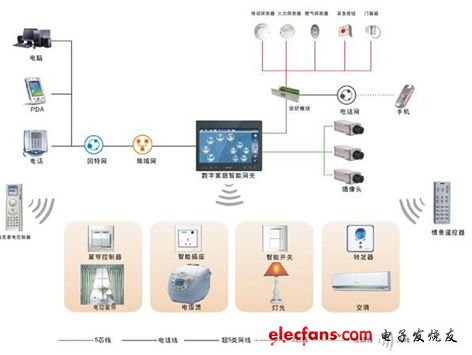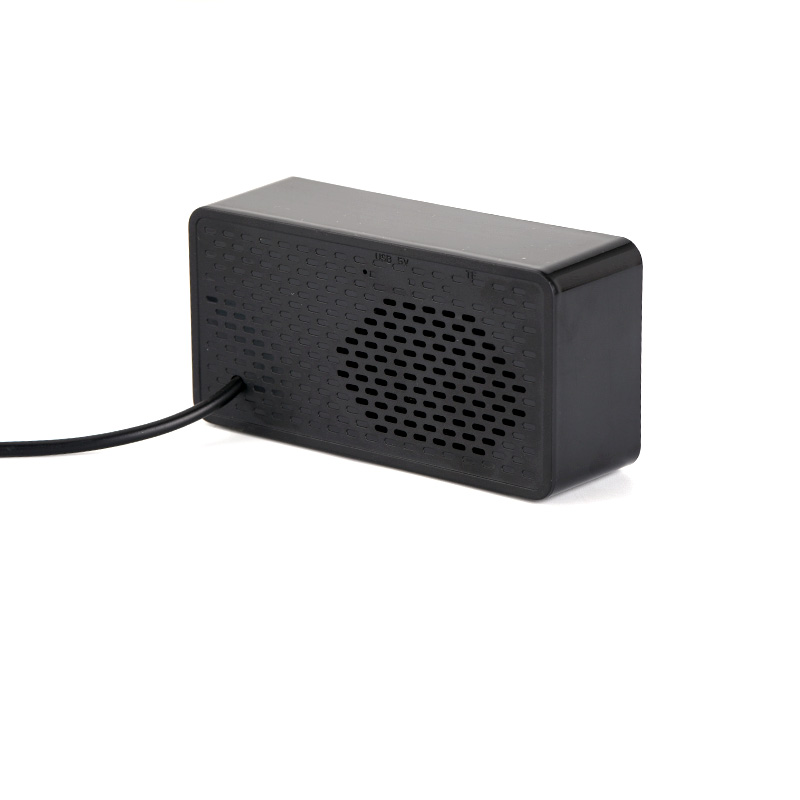Using wireless radio frequency technology to build a smart home
Modern homes have shifted from pursuing luxurious home furnishing to smart homes, enjoying the diversified information brought by smart homes, and a safe, comfortable and convenient living environment. In particular, the development of the Internet of Things and 3G mobile technology, intelligent life allows you to truly realize that home is always with you.
The smart home system is an efficient, comfortable, safe, convenient and environmentally friendly home living environment that uses computers, embedded systems and communication network technology, taking home as a platform and integrating automation, information and intelligence. At present, the degree of intelligence in smart home life depends on the efficiency and reliability of information transmission. There are mainly two types of wired transmission and wireless transmission. Wired transmission has the disadvantages of complex wiring, poor scalability, inconsistent standards, and difficult construction, and it is difficult to obtain a large market space. Wireless radio frequency technology is a short-range, low complexity, low data rate, low cost wireless communication technology, because it does not require rewiring, using point-to-point radio frequency technology to achieve the control of household appliances lighting and other equipment, and the installation is more convenient The control method is simple, and it has been widely used in smart homes in recent years. Therefore, the realization of intelligent life based on wireless radio frequency information transmission is the focus of current smart home research, which will provide people with an efficient, comfortable, safe and convenient living environment.
1. System Architecture
The smart home system based on radio frequency technology mainly includes a home gateway and several communication sub-nodes. A wireless transceiver module is configured in the home gateway and each wireless communication sub-node, and data and control information are transmitted between the gateway and each sub-node to realize information flow sharing between each other. The wireless communication sub-node mainly includes an intelligent remote controller, an intelligent sub-controller, and an intelligent switch.

The home intelligent gateway is the core of the system. It uses a 32-bit reduced instruction set computer ARM processor to build an embedded Linux operating system platform, and performs status setting and query through the keyboard or touch screen LCD display. The intelligent gateway is connected to the Internet and PSTN, and can convert the received control commands (including local remote control commands, remote phone voice commands, remote mobile phone commands, remote computer commands, etc.) into wireless radio frequency signals, and send the module through the radio frequency Launched to achieve intelligent home control.
On the one hand, the smart remote controller communicates with the home gateway through a wireless interface, and on the other hand, it has infrared self-learning function, which can decode, learn, and store the infrared code values ​​sent by different infrared remote controllers. One. The buttons on the LCD screen of the smart gateway correspond one-to-one with the keyboard of the smart remote control. The user defines different key descriptions on the buttons of the smart remote control and binds infrared codes with different control functions. The intelligent remote controller sends the learned infrared signal code value to the infrared intelligent control center or infrared sub-control center through the wireless transmission module to realize the registration of the infrared code value on the intelligent sub-controller. Enter the smart home control interface on the smart gateway and press the control button of an electrical device to transmit the code value through the wireless transmission module to the radio frequency signal; the smart sub-controller will the received wireless code value in the established list Carry out comparison, convert it into infrared signal and transmit it to realize the control of household appliances. The smart switch can receive the code value of the wireless signal transmitted by the smart gateway or the smart remote control to realize the switching action on the home appliance.
2. Features and advantages
With the continuous improvement of the digital community, the maturity of 3G technology and the continuous development of the security market, digital smart home systems have gradually become the mainstream of building intercom systems. Xiamen Lilin Technology has worked hard and worked hand-in-hand with many well-known universities to systematically integrate cutting-edge technologies such as Internet, multimedia, RF carrier, security, monitoring, detection, and biometrics, and adopts universal and comprehensive communication protocols to ensure the system ’s Transmission capacity and reliability, build a smart home platform that integrates a variety of systems. Especially based on wireless radio frequency technology to build a smart home system, with the help of 3G technology and Internet technology to achieve remote control functions, greatly improving people's lives.
(1) Optimize H.264 codec algorithm
The key to the digital smart home system based on radio frequency technology is how to use 3G technology and Internet technology to achieve remote control functions, especially how to improve the quality of remote video transmission. In response to this problem, focus on the H.264 codec algorithm, improve the most time-consuming motion estimation module in the H.264 encoding process, reduce the computational complexity of the H.264 codec, and effectively improve the H.264 codec Decoding efficiency to ensure better video transmission effect in the case of low bandwidth.
(2) Integration of the two networks
The building intercom system generally adopts a dedicated private network, that is, building a local area network, and each household communicates with each other through the local area network. The use of a dedicated network improves the stability and reliability of the system, but at the same time increases the cost. Lilin Technology's digital smart home system integrates the Internet and the digital building intercom system network into two networks, saving various costs caused by rebuilding the local area network. The system has been improved in terms of data compression and network transmission confidentiality, to minimize the impact of the digital building intercom system network on the original Internet, and realize the integration of the two networks and the sharing of the two networks. During actual installation and use, the residents only need to connect the digital terminal equipment to a certain port on their own switch, and connect other ports to the residential PC to realize the intercom of digital buildings in the community, while ensuring the Internet of the residential PC. access.
(3) System integration, self-contained system
Smart home can be integrated with security alarm, visual intercom, and remote control into a comprehensive platform to realize information sharing between each other and achieve the function of linkage control. At the same time, the smart home can form its own platform, and can be independently operated and controlled when it is disconnected from the system. By adopting this design method, it is satisfied that the smart home operation platform can also be realized in ordinary houses. Especially based on wireless radio frequency technology to achieve communication between the various home control devices, can facilitate the use of old houses without pre-laid lines.
(4) Mainnet subnet information sharing
The home gateway is a device in the home control subnet. The subgateway can be interconnected with the devices in the home control subnet, and at the same time provide various devices in the home control subnet with an interface to the home main network, so that each subnet The device can obtain various services and realize the configuration and management of the home control subnet. When disconnected from the home main network, each terminal device in the home control subnet can work normally. Each terminal device can share information and control functions with each other through the home control subnet. Through this mechanism, any control panel can be used to control the entire home.
(5) Bus conflict avoidance, single fire power
When the home main network and the home control subnet control terminal devices at the same time, a bus collision mechanism is adopted to avoid by priority. Especially in the wireless transmission, the fieldbus conflict avoidance mechanism is used flexibly to effectively solve the avoidance problem of multiple devices transmitting wireless signals at the same time. Data transmission adopts two-way control to improve the reliability and stability of the system, especially when the transmission data occurs, the bus conflict mechanism can be used more flexibly to avoid concessions. In order to take into account the convenient use of the old house without pre-laid lines, the system adopts the single fire power supply method, which is convenient for customers to install and retain the original wiring structure. Considering the small power consumption of single fire, the system enters the sleep mode in the normal state and waits for the external interrupt to trigger. The wireless receiving module uses an intermittent working mechanism, and the microprocessor discriminates intermittently, so that the system power consumption is reduced to a minimum, and energy saving and environmental protection are achieved.
(6) Flexible networking mode: wired and wireless combination
Considering the problem of signal attenuation during wireless radio frequency signal transmission, the system uses wired and wireless combination in the networking mode. Wireless radio frequency signals are used for data transmission on the same floor, and wired transmission is used between floors to realize the comprehensive and efficient sharing of system information.
(7) The three networks of the Internet, the home main network and the home control subnet
The Internet, home main network, and home control subnet are integrated into one network. The information sharing between the internal network and the external network. The smart home system based on the embedded Web server enables remote control through the network.
Conclusion
The smart home system based on radio frequency technology will integrate more platforms, adopt TCP / IP transmission protocol, and use the Internet transmission medium to achieve information sharing with each other, focusing on improving people's living standards. Especially driven by 3G mobile communication technology, the digital smart home system will go faster, higher and farther.
This mini Portable Speaker is specially designed for Desktop, Laptop, Notebook, Tablet PC. With small body and Lightweight,this usb Computer Speaker is convenient to carry.Its high-grade loud speaker will bring you much wonderful voice when listening to music,watching film or playing games. This USB Mini Speaker will be a super companion for your daily life.
The Portable mini speaker is USB-powered,plug and play,very easy.The mini sound box speaker is built-in volume control, very convenient to adjust volume. The Desktop Speaker is energy-saving and environmentally-friendly.It is safe and reliable.


USB Speaker
Speakers portable mini,Portable speaker mini,Speaker for computer,Usb speaker for computer
SHENZHEN HONK ELECTRONIC CO., LTD , https://www.honktech.com